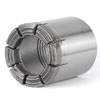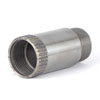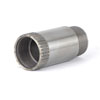- Impregnated
Diamond Type - Matrix Selection
Chart - Impregnation
Depth - Waterway
Configurations - Gauge Setting
Options - Bit Crown
Profiles - Wear
Patterns
Impregnated Diamond Type
The impregnated diamond core bit has emerged as the most commonly used type in the mineral exploration industry. The advantages of using impregnated diamond core bits over bits manufactured with other cutting media include:
- An extremely wide range of application.
- A simple crown geometry that makes them less susceptible to in-hole damage than bits produced with other types of cutting media and as such are more tolerant of changing or banded geological formations.
- Their multi-layered cutter arrangement results in better overall bit life than bits produced with other types of cutting media. They are particularly well-suited for drilling in hard, consolidated, non-abrasive formations.
Their multi-layered cutter arrangement results in better overall bit life than bits produced with other types of cutting media. They are particularly well suited for drilling in hard, consolidated, non-abrasive formations.
The basic construction of these bits features a sintered powdered metal crown that is fused to a steel tool body or shank. The powdered metal crown is composed of two layers: the “matrix” layer which cuts the rock and the “backing” layer which connects the matrix layer to the steel tool body and serves to support the gauge diameter protection hard materials.
The cutting media that is used in impregnated bits is NATURAL diamond. The material has a distinct advantage over the natural mined industrial diamond that is used in surface-set bits in that it is an engineered material that has measurable, controlled physical properties, particularly in the areas of crystal friability and crystal geometry.
The matrix layer of the bit crown contains a uniform distribution of these diamond crystals that are embedded in a powdered metal bond. The grit size and concentration of the synthetic diamond crystals as well as the relative hardness of the metal bond materials in which they are suspended are all functions of the matrix type designation.
IDP manufactures a range of impregnated diamond matrices with matrix layer metal bonds that range from hard, abrasion-resistant types to soft, ductile types. In general, a hard, abrasion-resistant matrix would be used to drill a soft, abrasive, unconsolidated formation while a soft, ductile matrix would be used to drill an extremely hard, non-abrasive, consolidated formation. The idea is to match the bit matrix hardness to the formation hardness in order that the metal bond of the matrix layer will erode at a controlled rate during normal drilling operation. This controlled erosion of the matrix layer metal bond will in turn continually expose new layers of sharp synthetic diamonds until the matrix layer of the bit crown is totally consumed.
Unlike the matrix layer, the & ldquo;backing layer” does not contain diamond distributed throughout its volume. The backing layer is also composed of a powdered metal bond material - usually a bond type with good wear resistance properties. Normally, the exposed outside and inside gauge diameter surfaces of this layer are set with a combination of natural mined “kicker” grade diamond and tungsten-carbide wear pads. These materials assist in maintaining the critical gauge diameters throughout the life of the bit. Optional setting is available whereby the natural mined “kicker” grade diamond is replaced with synthetic materials and is intended for use on drilling projects where potential contamination by natural diamond crystals is objectionable.
Matrix Selcetion Chart
IDP’s “I-Series” impregnated diamond core bits are designed to effectively drill any formation with a Moh’s hardness in the range of 4 to 8. The impregnated diamond matrix identification system provides a simple means of determining the correct matrix type to use for your job. In general, an impregnated diamond bit with a low identifying number such as & "l-2", would be used to drill a relatively soft, fractured and abrasive formation. As the numbers increase, the matrices are intended for use in increasingly harder formations up to the highest number,
"I-12", which would be used to drill an ultra hard, highly consolidated, non-abrasive formation.
When selecting a matrix type, consideration should be given to the capabilities of the drilling equipment in terms of its ability to function within IDP’s recommended operating parameters and also to variations in geological conditions. It may be necessary to select a harder or softer matrix type than what is recommended in this matrix selection chart in order to address drilling equipment limitations.
Impegration Depth
The term "impregnation depth" refers to the thickness of the diamond impregnated matrix layer on a core bit crown as shown in the illustration to the right. The variable “y” is used to define the impregnation depth dimension for a particular core bit.
IDP offers many sizes of core bits with standard impregnation depths of 6 mm (0.24 inch), 9 mm (0.35 inch) and 12 mm (0.47 inch). Other customer defined impregnation depths are available on request. Unless otherwise specified, a standard 9 mm impregnation depth is supplied for most North American sizes of core bits while a standard 6 mm impregnation depth is supplied for all thin-walled metric “I”, “T”, “TT”, “T2” and “T6”-series core bits.
As the price of an impregnated core bit increases from a 6 mm impregnation depth through to a 12 mm impregnation depth, consideration should be given to the economics of selecting a particular impregnation depth. While the initial cost of a core bit with a 6 mm depth of impregnation is relatively low, the expected overall bit life will also be lower than that of a bit with a thicker impregnation depth. For this reason, a 6 mm impregnation depth is generally recommended for use in shallow drill holes or for non-Wireline applications where more frequent bit changes are not objectionable. Conversely, the higher initial cost of a core bit with a 12 mm impregnation depth is largely offset by its inherently long bit life when used to drill extremely deep holes. The cost saving benefit is realized through reduced down time on the drill rig that would otherwise be required for tripping the drill string for bit changes.
Impregnation Depths for V-Ring Profile Core Bits

This bit crown profile is offered in standard impregnation depths of 6 mm (0.24 inch), 9 mm (0.35 inch) and 12 mm (0.47 inch). Note that impregnation depths greater than 9 mm (0.35 inch) are NOT available matrix core bits as well as those with kerf widths of less than 0.33 inch (8.4 mm). Customer specified impregnation depths of up to 14 mm (0.55 inch) are available on request for core bits with kerf widths of 0.39 inch (10 mm) or greater.

Impregnation Depths for Flat-Face Profile Core Bits
This bit crown profile is offered in standard impregnation depths of 6 mm (0.24 inch), 9 mm (0.35 inch) and 12 mm (0.47 inch). Note that impregnation depths greater than 9 mm (0.35 inch) are NOT available matrix core bits as well as those with kerf widths of less than 0.33 inch (8.4 mm). Customer specified impregnation depths of up to 14 mm (0.55 inch) are available on request for core bits with kerf widths of 0.39 inch (10 mm) or greater.
Impregnation Depths for Stepped Profile (Style ‘Z’) Core Bits
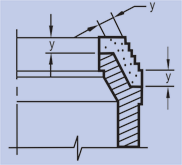 This bit crown profile is only offered with a standard impregnation depth of 6 mm (0.24 inch).
This bit crown profile is only offered with a standard impregnation depth of 6 mm (0.24 inch).Impregnation Depths for Semi-Round Profile (Style ‘U’) Core Bits
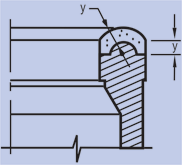 This bit crown profile is only intended for use on core bits with very thick kerf widths. It is available in customer specified impregnation depths ranging from 6 mm (0.24 inch) through 14 mm (0.55 inch) inclusive.
This bit crown profile is only intended for use on core bits with very thick kerf widths. It is available in customer specified impregnation depths ranging from 6 mm (0.24 inch) through 14 mm (0.55 inch) inclusive.Impregnation Depths for Flat-Face Profile Core Bits
This bit crown profile is offered in standard impregnation depths of 6 mm (0.24 inch), 9 mm (0.35 inch) and 12 mm (0.47 inch). Note that impregnation depths greater than 9 mm (0.35 inch) are NOT available matrix core bits as well as those with kerf widths of less than 0.33 inch (8.4 mm). Customer specified impregnation depths of up to 14 mm (0.55 inch) are available on request for core bits with kerf widths of 0.39 inch (10 mm) or greater.
Impregnation Depths for Stepped Profile (Style ‘Z’) Core Bits
This bit crown profile is only offered with a standard impregnation depth of 6 mm (0.24 inch).
Impregnation Depths for Semi-Round Profile (Style ‘U’) Core Bits
This bit crown profile is only intended for use on core bits with very thick kerf widths. It is available in customer specified impregnation depths ranging from 6 mm (0.24 inch) through 14 mm (0.55 inch) inclusive.
Waterway Configurations
Waterway Configurations for Impregnated Core Bits
Most sizes of impregnated core bits manufactured by IDP are offered in several different waterway configurations. These various waterway configurations have the function of controlling the bit hydraulics. In addition, the different waterway configurations influence the total bit face contact area presented to the rock face and as a result, control the amount of bit load to be applied for effective penetration. Some of the following core bit waterway configurations may not be available in certain bit sizes due to the dimensional limitations of that particular bit crown.
Regular Configuration (Style ‘W’)
Unless otherwise specified, this is the standard waterway configuration used on most types of impregnated core bits manufactured by IDP. This design uses canal type waterways that are approximately 0.12 inch (3 mm) wide. These waterways pass the circulating fluid from inside diameter of the bit crown, across the face and eject the fluid and cuttings at the outside diameter of the bit crown.
This waterway configuration is used primarily on thin-kerf core bits as well as wireline core bits that are intended for use in predominantly fractured formations.
The IDP code for this waterway configuration style is ‘W’. (Example: A IDP core bit with the descriptor ‘10W’ in its designation would indicate that the bit is supplied with 10 regular canal type waterways).
Face-Discharge Configuration (Style ‘FD’)
This waterway configuration is recommended for use when drilling in relatively soft, unconsolidated formations and/or when using triple-tube Wireline core barrel systems. Unlike core bits that are manufactured with conventional canal type waterways that eject the circulating fluid through ports on the inside diameter of the bit crown, the Face-Discharge configuration ejects the fluid through ports molded into the face of the bit. The re-direction of the circulating fluid results in minimum core wash and reduces the potential for subsequent core erosion. Each waterway element typically has a canal width of 0.25 inch (6.3 mm) with a flushing port diameter of 0.19 inch (4.8 mm).
When compared to any of the internal discharge waterway configurations, the Style ‘FD’ configuration develops relatively low fluid pressures across the bit face, even when higher circulation rates are applied. For reference in determining the appropriate bit load, impregnated diamond core bits that are manufactured with the Style ‘FD’ waterway configuration have bit face contact areas that are similar to that of same size core bits manufactured with the Style ‘T’ waterway configurations. The Style ‘FD’ waterway configuration is available on all Wireline core bits as well as on core bits with kerf widths greater than 0.34 inch (8.5 mm) that are used with conventional (non-Wireline) core barrel systems.
The IDP code for this waterway configuration style is ‘FD’. (Example: A IDP core bit with the descriptor ‘8FD’ in its designation would indicate that the bit is supplied with 8 face-discharge type waterways).
Junk SlotsThese are large output fluid passages that are molded into the outside diameter of a surface-set diamond bit crown to permit the ejection of large cuttings from the face of the bit. Typically, the addition of junk slots to a surface-set bit crown is restricted to large diameter coring and non-coring bits used in geotechnical and petroleum drilling applications where the formations are relatively soft and abrasive, the bit is set with either large particle size diamonds or PCD elements and the resulting cuttings tend to be long and sheared.
The number of junk slots that may be placed on a bit crown is a function of both its diameter and waterway configuration and must be divisible by the number of input waterways in order to establish a uniform pattern. The preferred number of junk slots is three (equally spaced) in order to preserve the dynamic balance of the bit during operation. Consideration should also be given to the effect of reducing the amount of outside gauge diameter setting resulting from the incorporation of junk slots into the bit crown design.
Gauge Setting Options
As both the hole diameter and core diameter dimensions that are cut by a core bit must be consistent, the inside and outside gauging sections on all IDP impregnated diamond bit crowns are set with cutting media in order to preserve these critical dimensions.
Unless otherwise specified, all impregnated core bits produced by IDP have their inside and outside set diameter gauging sections set with a combination of seismic grade tungsten-carbide wear pads and kicker grade natural diamond. Note that due to physical space constraints, the tungsten carbide wear pads are usually omitted on thin-wall impregnated diamond core bits with kerf widths of 0.30 inch (7.6 mm) or less.
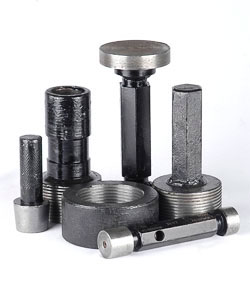 An optional setting arrangement may be specified where the kicker grade natural diamond is replaced with synthetic, angular shaped, thermally stable polycrystalline diamond (PCD) particles. Impregnated diamond bits with this type of optional gauge setting are classified as “PCD-SET” in their descriptions. There is no measurable difference in performance between impregnated diamond bits of the same matrix type and waterway configuration that are set with natural kicker grade diamond and those that are set with synthetic PCD chips. The application of “PCD-SET” impregnated diamond bits is usually limited to drilling projects where the use of natural diamonds as gauge setting is viewed as a potential contaminant. As an example, “PCD-SET” impregnated diamond bits are commonly used in the investigation of diamond bearing Kimberlitic formations.
An optional setting arrangement may be specified where the kicker grade natural diamond is replaced with synthetic, angular shaped, thermally stable polycrystalline diamond (PCD) particles. Impregnated diamond bits with this type of optional gauge setting are classified as “PCD-SET” in their descriptions. There is no measurable difference in performance between impregnated diamond bits of the same matrix type and waterway configuration that are set with natural kicker grade diamond and those that are set with synthetic PCD chips. The application of “PCD-SET” impregnated diamond bits is usually limited to drilling projects where the use of natural diamonds as gauge setting is viewed as a potential contaminant. As an example, “PCD-SET” impregnated diamond bits are commonly used in the investigation of diamond bearing Kimberlitic formations.Bit Crown Profiles
Bit Crown Profiles for Impregnated Diamond Core Bits
Most sizes of impregnated diamond core bits manufactured by IDP are offered in several different bit crown profiles, each of which has a specific range of application depending on the drilling conditions encountered. Some of the following bit crown profiles may not be available in certain bit sizes due to the kerf width limitations of that particular bit crown. “Kerf width” is defined as the dimension measured across the width of the bit crown profile, that is: 0.5 x (Crown Outside Diameter - Crown Inside Diameter).
V-Ring Profile (Style ‘V’)
Unless otherwise specified, this profile is the standard for all Wireline core bits as well as core bits with kerf widths greater than 7 mm (0.27 inch) that are used on conventional core barrel systems. This bit crown profile provides good penetration rates with relatively low bit loads. It is recommended for use in hard, consolidated formations and will usually provide better initial penetration rates than a bit manufactured with the “Flat-Face” (Style ‘F’) profile.
Flat-Face Profile (Style ‘F’)
This profile is the standard for all impregnated diamond core bits with kerf widths of 7 mm (0.27 inch) or less. It is also recommended for impregnated diamond core bits with kerf widths in the 7 to 20 mm (0.27 to 0.79 inch) range that are intended for use in predominantly fractured formations. This profile is less susceptible to in-hole damage than bits that are manufactured with the “V-Ring” (Style ‘V’) or the “Stepped” (Style ‘Z’) profiles. When applied in hard, consolidated formations, the “Flat-Face” profile tends to require less initial in-hole conditioning than a “V-Ring” (Style ‘V’) profile bit but usually requires the use of higher rotational speeds during the initial break-in period in order to establish a good rate of penetration.
Semi-Round Profile (Style ‘U’)
Unless otherwise specified, this profile is the standard for all impregnated diamond core bits with kerf widths of 25 mm (0.98 inch) or greater. It is also recommended for use in highly fractured formations. The “Semi-Round” (Style ‘U’) profile is particularly well suited for use in wide-kerf core bits as it tends to distribute the bit load across the bit face more equally than either the “Flat-Face” (Style ‘F’) or the “V-Ring” (Style ‘V’) profiles. As a result, this bit crown profile will reduce the risk of “bit bouncing” during operation.
Wear patterns
When an impregnated core bit is removed from the drill-hole after use, the resulting wear pattern on the bit face is an important source of information for the operator. By “reading” the bit face, the operator can frequently troubleshoot problems by simply altering the drill’s operating parameters or by changing the bit to a matrix type or waterway configuration that is better suited to the ground conditions.
New Condition
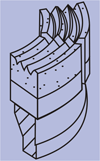 For reference purposes, this graphic illustrates the appearance of a new, unused impregnated diamond core bit crown
For reference purposes, this graphic illustrates the appearance of a new, unused impregnated diamond core bit crown Ideal Wear Pattern
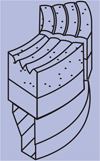 The observed mid-life wear pattern on a properly used impregnated diamond core bit should be relatively flat with slightly chamfered sides.
The observed mid-life wear pattern on a properly used impregnated diamond core bit should be relatively flat with slightly chamfered sides. Outside Diameter Gauge Loss
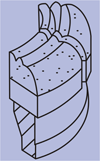 Possible causes and solutions:
Possible causes and solutions:
- Vibration - Lower the rotational speed.
- Lack of in-hole fluid circulation - Increase the pump rate.
- The bit is reaming an undersized drill hole - Check the gauge diameter of the reaming shell in use and replace if found to be undersized.
Inside Diameter Gauge Loss
 Possible causes and solutions:
Possible causes and solutions:
- Overfeeding the bit - Reduce the penetration rate.
- Damage from drilling into highly unconsolidated material - Cement the drill hole or change to a harder (lower number) Dimatec “D-Series” matrix type.
- Drilling over lost core - Examine the core tube contents.
- Lack of fluid circulation - Check the inner tube length adjustment to ensure that there are no fluid restrictions within the core barrel assembly. Also check the in-hole circulation pump rate and the drill rod string for leaks
Cracked Waterways
 Possible causes:
Possible causes:
- An excessive bit load was applied.
- The bit, core barrel and drill rod string were accidentally dropped in the drill hole.
- The wireline inner tube assembly was accidentally allowed to free fall through the drill rod string in a dry hole.
- The bit was accidentally crushed by the rod holder or foot clamp
Concave Face Wear
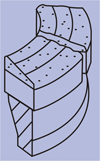 Possible causes and solutions:
This wear pattern frequently results from the use of a penetration rate that is too high for the rotational speed being used (overfeeding). This wear pattern is also caused by “grinding core”.
Possible causes and solutions:
This wear pattern frequently results from the use of a penetration rate that is too high for the rotational speed being used (overfeeding). This wear pattern is also caused by “grinding core”.
Convex Face Wear
 Possible causes and solutions:
Possible causes and solutions:
- Insufficient fluid circulation across the bit face - Check the circulation pump and drill rod string for leaks; increase the pump rate.
- Repeated in-hole “dry-stripping” in hard, non-abrasive formations - Change to a softer (higher number) Dimatec “D-Series” matrix type
Excessive Diamond Exposure
 In this wear pattern, the metal-bond matrix abrades away before the diamond crystals have become worn. As there is insufficient metal-bond matrix material to support the over-exposed diamond crystals on the bit face, the diamonds are released from the matrix material prematurely resulting in low bit life. Possible causes and solutions:
In this wear pattern, the metal-bond matrix abrades away before the diamond crystals have become worn. As there is insufficient metal-bond matrix material to support the over-exposed diamond crystals on the bit face, the diamonds are released from the matrix material prematurely resulting in low bit life. Possible causes and solutions:
- The penetration rate is too high for the rotational speed in use (overfeeding) - Reduce the penetration rate or increase the rotational speed.
- The matrix type is too soft for the ground conditions - Change to a harder (lower number) Dimatec “D-Series” matrix type
Glazed Bit Face
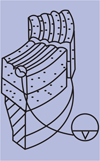 Possible causes and solutions:
In this condition, the diamond crystals on the bit face have become completely embedded in the metal-bond matrix. Sandblast the bit face in order to re-expose the diamond crystals. Try drilling with a slower rotational speed and/or a lower in-hole fluid circulation rate in an effort to cause the metal-bond matrix to abrade at a higher rate that will cause the diamond crystals to become exposed more readily. If the bit face glazes repeatedly, change to a softer (higher number) Dimatec “D-Series” matrix type.
Possible causes and solutions:
In this condition, the diamond crystals on the bit face have become completely embedded in the metal-bond matrix. Sandblast the bit face in order to re-expose the diamond crystals. Try drilling with a slower rotational speed and/or a lower in-hole fluid circulation rate in an effort to cause the metal-bond matrix to abrade at a higher rate that will cause the diamond crystals to become exposed more readily. If the bit face glazes repeatedly, change to a softer (higher number) Dimatec “D-Series” matrix type.
Burnt Bit Crown
 This condition is the result of a significant loss of fluid circulation across the bit face. Possible causes for this condition include:
This condition is the result of a significant loss of fluid circulation across the bit face. Possible causes for this condition include:
- The operational failure of the fluid circulation pump.
- Excessive circulation fluid leaks in the drill rod string, water swivel or hoses.
- Internal core barrel fluid restrictions resulting from the incorrect adjustment of the wireline inner tube assembly.
- One or more waterway canals on the bit crown are blocked by pebbles or other debris.




